Fiddle leaf fig leaves curling up isn’t just an unpleasant sight – it is a symptom of various other issues that range from a mild annoyance to more serious.
No matter what the cause, it’s best to spring into action and get the matter taken care of before these fiddle leaf fig problems threaten the life of the plant.
Keep reading to find out what to do if you see your Ficus starting to look less than ideal, as well as how to stop it happening again.
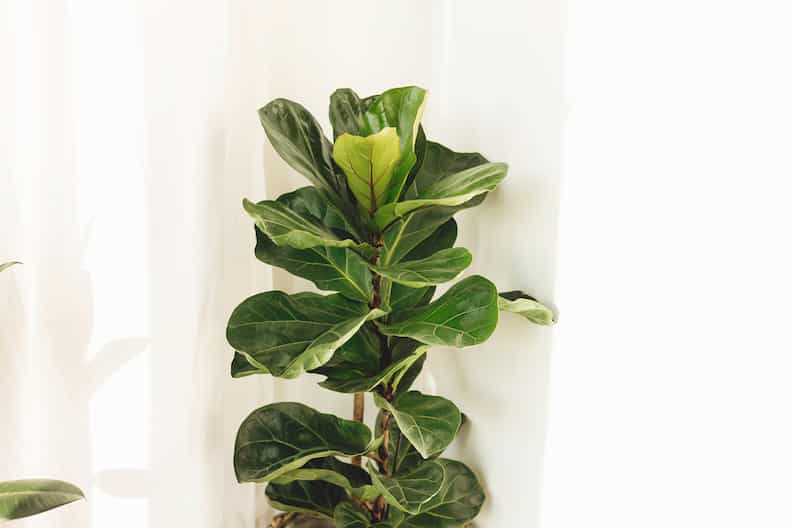
Table of Contents
Why are my fiddle leaf fig leaves curling up?
Fiddle leaf figs are not difficult plants to care for, but that doesn’t mean you can leave them and forget about them. In many cases, the reasons why a fiddle leaf fig leaves curling up are directly connected to improper care.
The good news is that you can keep this issue at bay by keeping your fiddle leaf fig healthy and happy.
1. Soil too dry
When the soil is dry and the fiddle leaf fig leaves curling inward, that is a sign that the plant is not getting enough water. This can also lead to the plant’s leaves feeling dry and crumbling, leaf drop, stunted growth, and wilted stems and leaves. If not corrected, the plant will slowly die from dehydration.
2. Sun scorched
If the fiddle leaf fig tree leaves are curling and brown, you probably have a case of sun scorch on your hands. While fiddle leaf figs do need an abundance of sunlight for healthy growth, too much sun or direct sunlight can cause your fiddle leaf fig’s leaves to become sunburned.
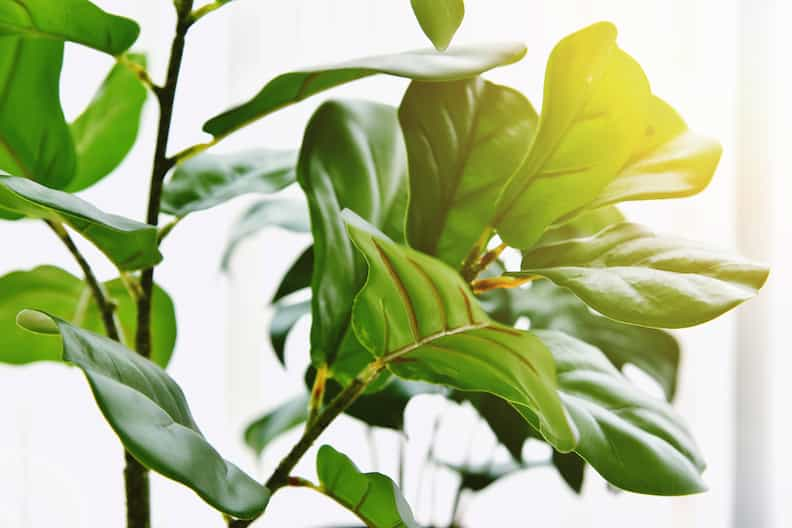
3. Fungal disease
There are several different types of fungal diseases, and just about all of them can cause the leaves of your fiddle leaf fig to curl upward. To make matters even worse, fungal diseases are notorious for being difficult to get rid of and can even spread from one plant to another.
4. Lack of nutrients
Not providing plants with nutrients will affect the entire health and wellness of the plant, and it can even cause the leaves to curl. Far too often, gardeners assume that plants, especially houseplants, will get all the needed nutrients from the soil they are growing in.
Unfortunately, growing medium for indoor houseplants does not have the same level of nutrients that one can find outside. This is because, without fertilizing your fiddle leaf fig, the indoor soil isn’t getting the same recharge as the soil in your outdoor garden.
Best fertilizer for Fiddle Leaf Figs
Miracle-Gro Water Soluble All Purpose Plant Food
A great fertilizer with the perfect balance for your fiddle leaf fig. Simply dissolve in water and feed your plant to watch it thrive.
5. Overwatering the plant
Like underwatering, overwatering can cause leaf curling, as well as deformed leaves on a fiddle leaf fig. What’s even worse is that too much water increases the chance of root rot and various other diseases. Along with leaf curling, overwatering will cause stunted growth, mold and mildew growth, wilted and droopy leaves, soggy blisters on the foliage, weak stems, and an unpleasant odor.
Overwatering the fiddle leaf fig is one of the quickest ways to ensure the plant won’t survive much longer. Depending on the severity of the overwatering, the fiddle leaf fig may not snap back to a healthy plant once the overwatering is stopped.
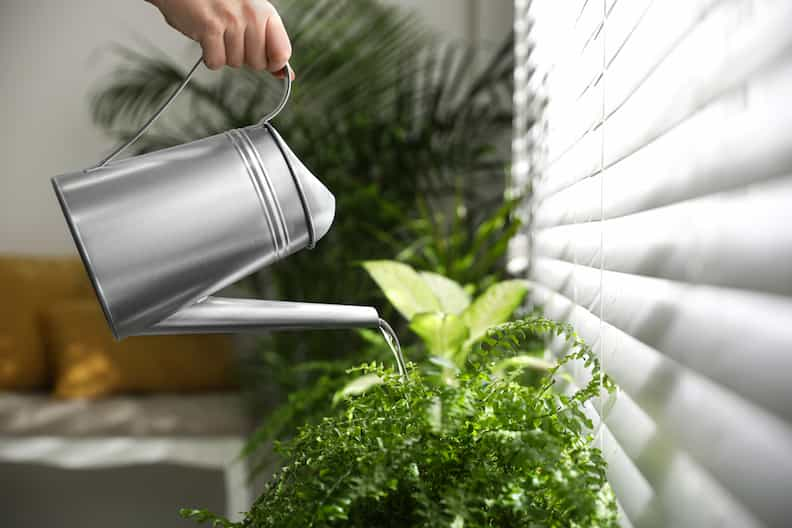
6. Wrong temperature
As a plant that’s native to Africa, fiddle leaf figs need a constant temperature of 60 to 80 degrees Fahrenheit. Without this constant temperature, you would see the fiddle leaf fig leaves curling up.
Furthermore, if the plant continues to not receive the correct growing temperature, it can go into shock, experience stunted growth, and even die.
7. Insect infestation
Pests can cause a slew of problems to plants, including affecting the appearance of fiddle leaf fig leaves. Leaf curling is one such symptom of an insect infestation, as well as small brown spots on your fiddle leaf fig or holes covering the leaves.
Depending on how bad the infestation is, you may also notice the fiddle leaf fig tree is not growing properly and looking worse for the wear.
8. Overfeeding the plant
While houseplants of all kinds need a little feeding every once again, giving them too much fertilizer can cause just as many problems as not fertilizing the plant.
Fertilizers contain various nutrients that, when given in the right ratio, can boost the plant’s growth and health. If, however, you give the plant too much of these nutrients, the plant can “overdose” on the nutrients.
Furthermore, overfeeding can cause the fiddle leaf fig to have a quick growth spurt, which may seem like a good thing at first. Unfortunately, the plant’s root system usually cannot handle this quick growth.
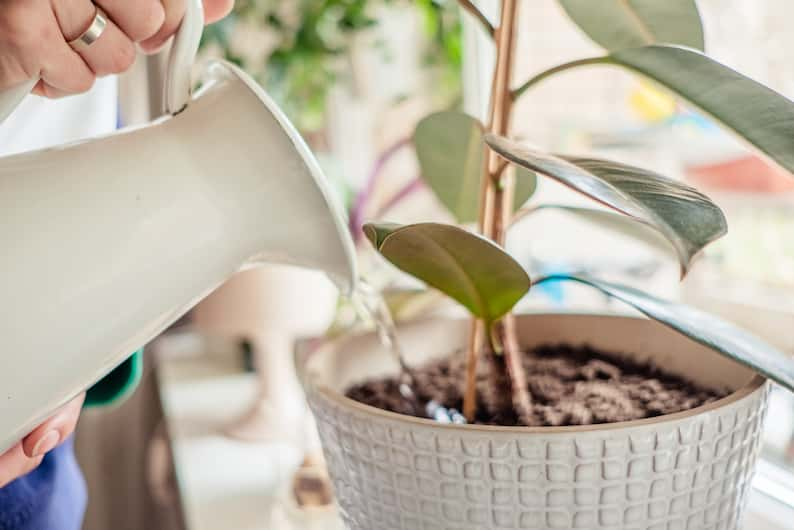
9. Poor water quality
The quality of the water you are using to hydrate the fiddle leaf fig can have a direct impact on its overall health and wellness. It can also cause the fiddle leaf fig leaves curling upward or inward. Tap water is usually what gardeners use to water their plants.
While it is easy to access, tap water typically contains chlorine and various other chemicals and minerals that can have a negative effect on fiddle leaf figs. Furthermore, the pH level of tap water typically doesn’t fall within the ideal range of 6.5.
10. Root rot
Root rot in your fiddle leaf fig is a direct result of overwatering. This fungal disease is, unfortunately, not an uncommon fiddle leaf fig problem. Not only does it cause leaf curling, but it also creates water blisters on the leaves, weak and soggy stems, and even death to the plant.
The good news is that this disease is easy to prevent, you just have to not overwater the plant. The bad news, however, is that it can be difficult to save a plant that has root rot. The entire plant will need to be removed from its current pot, the soggy soil around the roots will need to be removed, and the plant will then need to be repotted in a clean container with fresh, non-soggy soil.
Even after all that, there is no guarantee that the plant will survive its experience. That is why it is important to prevent root rot beforehand by not overwatering the plant.
11. Leaf spot disease
Leaf spot is another common fungal disease that can affect various houseplants, including fiddle leaf figs. Symptoms of this disease include brown spots or black dots on the foliage, as well as curled or discolored leaves.
While it’s no fun dealing with any type of fungal disease, leaf spot is one of the easiest fungal issues to correct. In most cases, the plant will make a full recovery after several weeks or months.
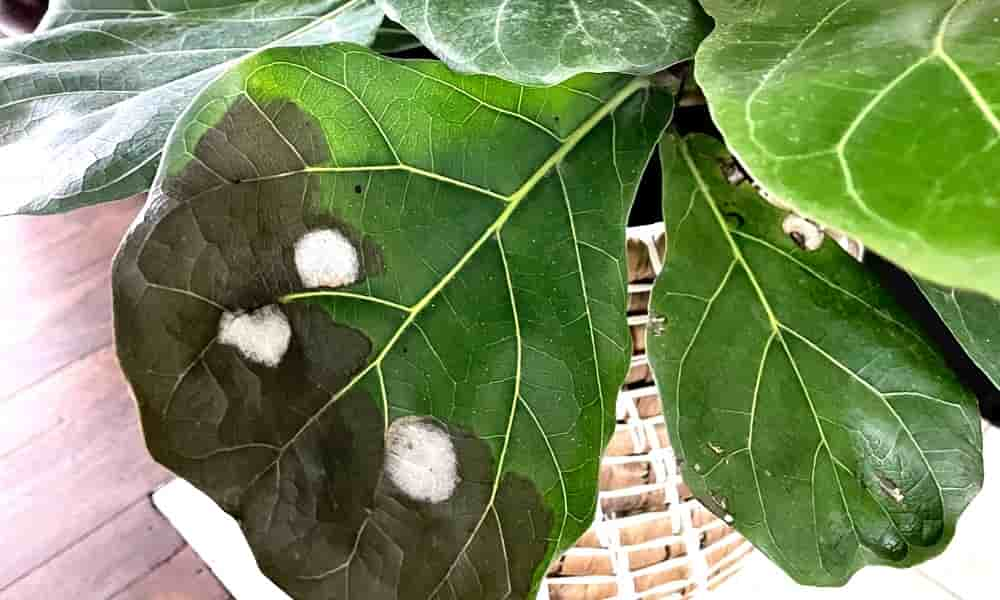
12. Low humidity levels
Fiddle leaf figs are humidity lovers and thrive in an environment where humidity levels are 40% to 60%. When the humidity levels are below this percentage, the plant can begin to experience the same symptoms as not getting enough water, which include curling leaves.
13. Bad soil quality
Soil is a vital part of a healthy plant that can sometimes be overlooked. No matter what you may think, not all soil is made equal, and not growing your fiddle leaf fig in the best soil for its needs can cause your plant to experience leaf curling and various other unpleasant symptoms.
If the plant is left to continue growing in the poor soil, it can show signs of stunted growth and even become susceptible to pest and disease problems.
Best soil for Fiddle Leaf Figs
Miracle-Gro Tropical Potting Mix
Light and well-draining (perfect for avoiding root rot) while being packed with just the right nutrients – that will feed your plant for up to six months. The best soil for keeping your fiddle leaf fig healthy and strong.
How do you treat leaf curl on a fiddle leaf fig tree?
Now that you know the causes of fiddle leaf fig leaves curling up, let’s discuss how you can treat the problem.
Keep in mind, however, that the best defense against this problem is to take the necessary preventive steps to keep the issue from occurring in the first place. Implementing preventive measures will prevent the leaf curling from affecting your plant in the future.
1. Provide the fiddle leaf fig with the correct amount of water
Since both underwatering and overwatering can cause fiddle leaf fig problems, it is vital that you ensure the plant is getting the right amount of water. The good news is that by simply testing the moisture level of the soil before watering, you can prevent overwatering or underwatering your fiddle leaf fig.

To do this, simply stick your finger 2 inches into the soil. Water if the soil feels dry. For soil that still feels moist, wait another day or two before checking again. Only water the fiddle leaf fig when the soil feels dry.
While several different factors can affect this timeline, many gardeners find that they only have to water their plants once every 10 to 14 days. The temperature, humidity level, and whether or not the plant is in its active growing period can all affect how often you will need to water the fiddle leaf fig.
Find out more: How Often Should You Water a Fiddle Leaf Fig?
2. Avoid direct sunlight
Direct sunlight is usually the second leading cause of leaf curl in the fiddle leaf fig tree. While it is true that fiddle leaf figs do love their sunlight, it can leave the plant’s leaves brown, curled, burnt, and looking less than desirable.
The good news is that you can easily correct the problem by moving the fiddle leaf fig out of direct sunlight and into a location where it can receive bright, indirect light. Based on the fiddle leaf fig’s light needs, a window that has a sheer curtain blocking the sunlight is an ideal location. Another option is to set the fiddle leaf fig near an east-facing window as these usually get indirect sunlight throughout the day.
3. Prevent fungal diseases
Fungal diseases are the bane of gardeners both indoors and out. There are just so many different types of fungal diseases that can affect plants, and many of them cause fiddle leaf fig leaves curling up. No matter what type it is, however, the best defense against them is prevention.
Ensuring the fiddle leaf fig is healthy is the ideal way to keep fungal diseases at bay. It is no secret that fungal diseases, as well as insect problems, are more likely to occur on an unhealthy plant than on a healthy one. This is because unhealthy plants are an open invitation to problems, and healthy ones are more likely to have the strength to fight off problems.
You can keep the fiddle leaf fig healthy by providing the plant with its ideal growing conditions, and ensuring the plant is getting the right amount of water and sunlight.
4. Fertilize the fiddle leaf fig during its active growing period
Fertilizing the fiddle leaf fig will help improve the overall health of your plant, while also preventing leaf curl. Just make sure that you provide the tree with the right kind of fertilizer and only apply it during the plant’s active growing period.
If you cannot find fertilizer specifically designed for the fiddle leaf fig, an all-purpose houseplant fertilizer will work in a pinch. No matter what type you use, be sure to use the recommended dosage found on the fertilizer bottle.

5. Make sure the fiddle leaf fig has the correct temperature
Even though fiddle leaf figs are not too picky when it comes to their growing environment, they do need a certain temperature to keep the plant healthy. The ideal temps for fiddle leaf figs are between 60 and 80 degrees. Furthermore, you will need to ensure the plant isn’t subjected to drastic temperature fluctuations, such as what can occur near a heating/cooling vent or exterior door.
If you’re having difficulties providing the plant with the right temperature, consider moving the fiddle leaf fig to a small room in your home where you can shut the door and keep the room at the correct temperature at all times. Sometimes it is easier to try to control the temperature in a smaller room than an entire living room.
6. Keep insects and pests at bay
Insects are an all too common problem that can lead to leaf curls. The most common insects that attack indoor fiddle leaf figs are spider mites, mealybugs, and thrips. These plants insert their mouthparts into the leaves and stems of the plant and suck out the juices.
This can cause the leaves to develop small holes or brown spots, leaf curling, wilted or drooping leaves, and leaf drop on your fiddle leaf fig. The best way to prevent an insect or pest problem is to keep the plant healthy, since a healthy plant is less likely to come under attack by pests.
If you do notice any of these sap-sucking insects on your plants, treat as soon as possible with insecticidal soap. Insecticidal soap is a safer alternative to harsh chemical pesticides and can be used around people and pets. It also doesn’t harm fish, birds, wildlife, and beneficial insects, such as bees.
7. Don’t overfeed the fiddle leaf fig
Making sure you provide the right amount of fertilizer without giving the fiddle leaf fig too much will go a long way to preventing problems, including leaf curl. To prevent overfeeding, select a fertilizer designed for fiddle leaf figs and only apply it during the plant’s active growing period.

Furthermore, follow the instructions located on the back of the fertilizer as this will give you the exact amount to give to your plant. Never feed the fiddle leaf fig when it is dormant, which is in late fall and winter.
Another option is to forgo the commercially available fertilizer and use household green waste to feed the plants. Things like coffee grounds, eggshells, and banana peels can be added to a compost pile and then used to naturally fertilize the fiddle leaf fig.
8. Use the right kind of water
Fiddle leaf figs, as well as other houseplants, grow best when given rainwater or spring water. Both of these types of water have a pH level that is closer to the 6.5 mark that plants seem to love. The downside to spring water is that it can get a bit costly, which leaves rainwater as the ideal choice.
Furthermore, avoid giving your fiddle leaf fig cold water as this can shock the tree. Instead, let the water warm to room temperature beforehand.
9. Control leaf spot disease
The good news is that leaf spot disease is usually easy to correct, and requires removing the affected leaves. Once the fungal disease has attacked the leaf, it cannot be saved. And since the disease can spread, the best course of action is to simply cut the damaged leaves and discard them in the trash.
You will also need to avoid getting the foliage of the plant wet when watering as this can lead to leaf spot disease recurring. Make sure to also clean and sanitize the cutting shears used to remove the diseased leaves as pathogens can transfer from one plant to the next when using the same gardening tools.
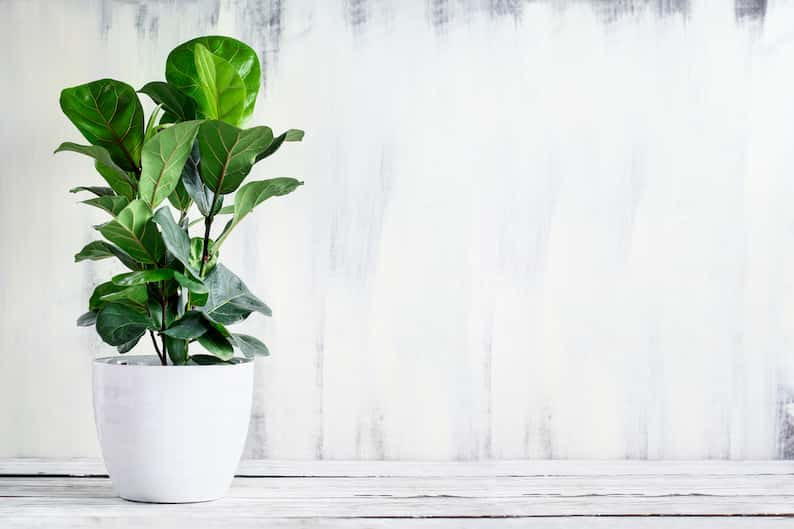
10. Keep humidity levels high
There are a couple of ways you can increase the humidity levels in your home. One of the easiest methods is to simply purchase a humidifier and place it near the fiddle leaf fig. Humidifiers are small appliances that will put moisture in the air to increase the humidity level.
Another option is to make a pebble tray and place the fiddle leaf fig on top of the tray, which is a shallow dish lined with pebbles. When you water the fiddle leaf fig, the excess water that drains out the bottom of the pot will collect in the tray. This water will then naturally evaporate, which increases the humidity level of the air around the plant.
11. Grow the fiddle leaf fig in the right soil
The right type of soil is essential for any healthy plant, and the fiddle leaf fig is no exception. Fiddle leaf figs need well drained soil that isn’t compact. Compact soil prevents the water from flowing freely and increases the chance of soggy roots, fungal disease, and root rot.
To keep leaf curl and other fiddle leaf fig problems at bay, make sure to grow the plant in soil that has a high organic matter and is peat based with a bit of perlite mixed in. The soil should also have a pH level that is slightly acidic with a pH balance between 5.3. to 6.7.
A good general rule of thumb is to use soil that is 2/3 peat and 1/3 perlite. Some gardeners prefer to use potting soil made for cacti. No matter what type of soil you use, however, make sure it is well drained, light, and airy.
Final thoughts
If you notice your fiddle leaf fig leaves curling upward or inward, while it’s not ideal, you can also be reassured that it’s one of the most common fiddle leaf fig problems. This is because, as you can probably tell, it’s one of the first symptoms that something isn’t quite right in your plant’s maintenance schedule.
Fortunately, it’s usually a very easy issue to fix with no long term effects on the plant if it’s caught quickly enough. Instead, it often comes down to it being a process of elimination. This means that as soon as, say, you notice that your fiddle leaf fig’s new leaves are curling and turning brown, it’s time to review how you’ve been treating your plant lately.
From there, with some tweaks to your fiddle leaf fig’s care, you should be able to address the root cause and get your Ficus back to its happy, thriving self in no time.


